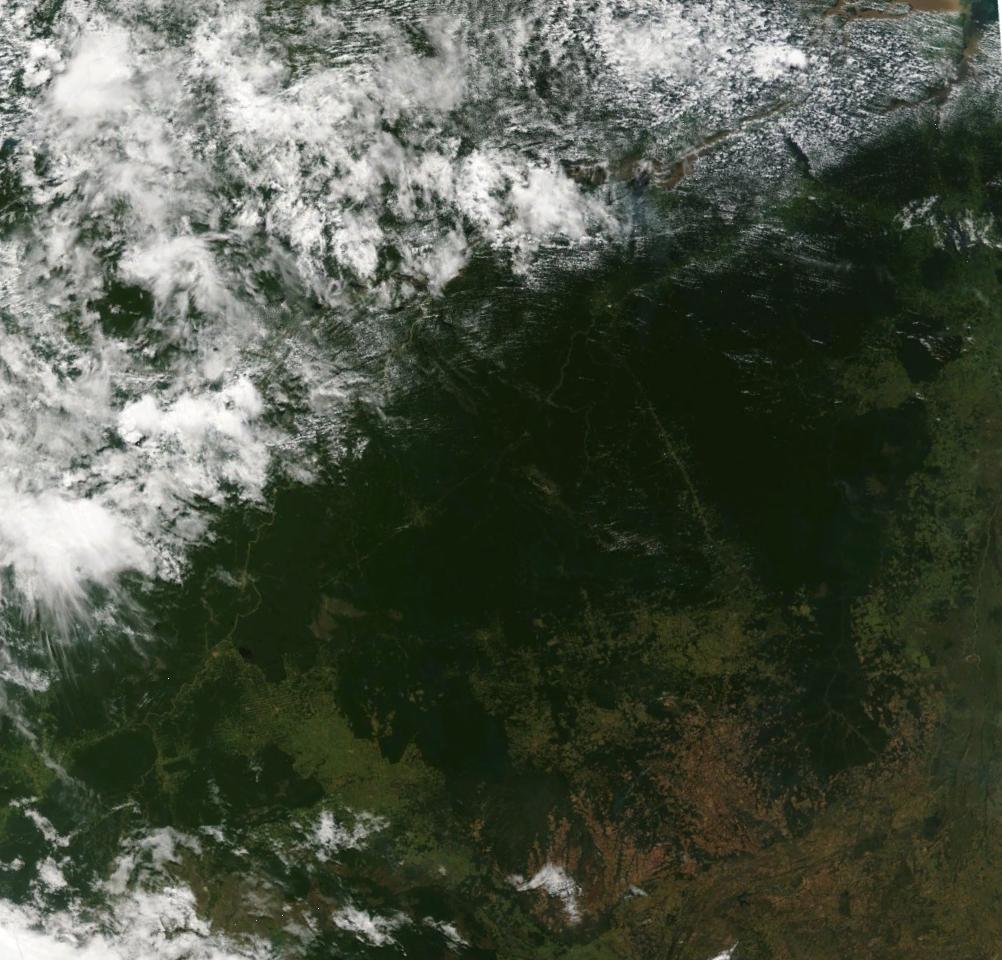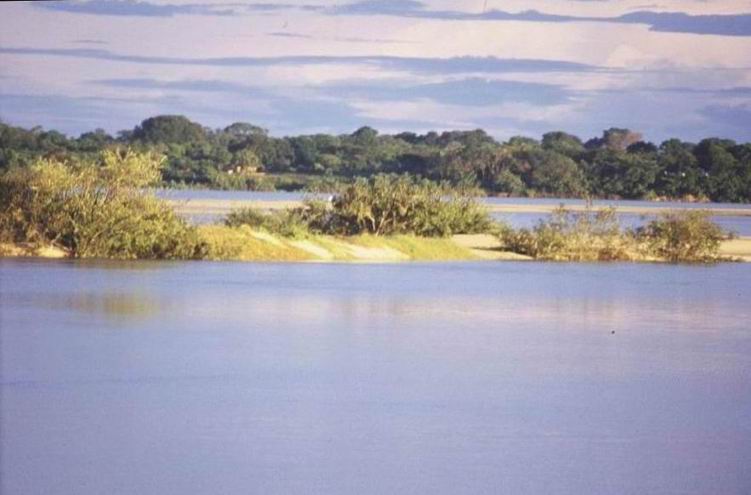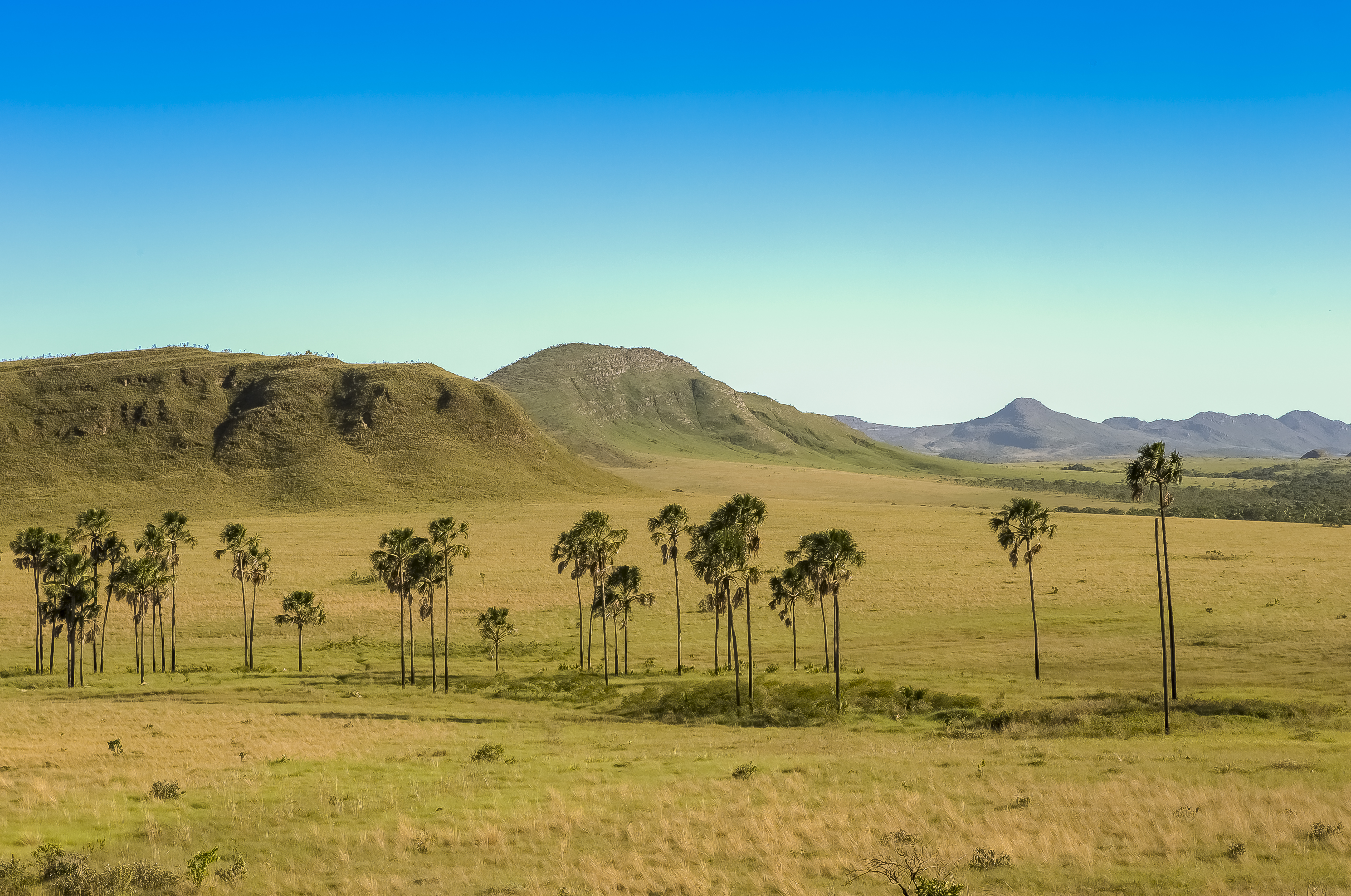|
Tocantins State
Tocantins () is one of the 26 states of Brazil. It is the newest state, formed in 1988 and encompassing what had formerly been the northern two-fifths of the state of Goiás. Tocantins covers and had an estimated population of 1,496,880 in 2014. Construction of its capital, Palmas, began in 1989; most of the other cities in the state date to the Portuguese colonial period. With the exception of Araguaína, there are few other cities with a significant population in the state. The government has invested in a new capital, a major hydropower dam, railroads and related infrastructure to develop this primarily agricultural area. The state has 0.75% of the Brazilian population and is responsible for 0.5% of the Brazilian GDP. Tocantins has attracted hundreds of thousands of new residents, primarily to Palmas. It is building on its hydropower resources. The Araguaia and Tocantins rivers drain the largest watershed that lies entirely inside Brazilian territory. The Rio Tocantins ... [...More Info...] [...Related Items...] OR: [Wikipedia] [Google] [Baidu] |
Federative Units Of Brazil
The federative units of Brazil ( pt, unidades federativas do Brasil) are subnational entities with a certain degree of autonomy (self-government, self-regulation and self-collection) and endowed with their own government and constitution, which together form the Federative Republic of Brazil. There are 26 states (') and one federal district ('). The states are generally based on historical, conventional borders which have developed over time. The states are divided into municipalities, while the Federal District assumes the competences of both a state and a municipality. Government The government of each state of Brazil is divided into executive, legislative and judiciary branches. The state executive branch is headed by a state governor and includes a vice governor, both elected by the citizens of the state. The governor appoints several secretaries of state (each one in charge of a given portfolio) and the state attorney-general. The state legislative branch is the legislati ... [...More Info...] [...Related Items...] OR: [Wikipedia] [Google] [Baidu] |
Human Development Index
The Human Development Index (HDI) is a statistic composite index of life expectancy, education (mean years of schooling completed and expected years of schooling upon entering the education system), and per capita income indicators, which is used to rank countries into four tiers of human development. A country scores a higher level of HDI when the lifespan is higher, the education level is higher, and the gross national income GNI (PPP) per capita is higher. It was developed by Pakistani economist Mahbub ul Haq and was further used to measure a country's development by the United Nations Development Programme (UNDP)'s Human Development Report Office. The 2010 Human Development Report introduced an Inequality-adjusted Human Development Index (IHDI). While the simple HDI remains useful, it stated that "the IHDI is the actual level of human development (accounting for inequality), while the HDI can be viewed as an index of 'potential' human development (or the maximum l ... [...More Info...] [...Related Items...] OR: [Wikipedia] [Google] [Baidu] |
Cerrado
The ''Cerrado'' (, ) is a vast ecoregion of tropical savanna in eastern Brazil, particularly in the states of Goiás, Mato Grosso do Sul, Mato Grosso, Tocantins, Minas Gerais, and the Federal District. The core areas of the Cerrado biome are the Brazilian highlands – the ''Planalto''. The main habitat types of the Cerrado consist of forest savanna, wooded savanna, park savanna and gramineous-woody savanna. The ''Cerrado'' also includes savanna wetlands and gallery forests. The second largest of Brazil's major habitat types, after the Amazonian rainforest, the Cerrado accounts for a full 21 percent of the country's land area (extending marginally into Paraguay and Bolivia). The first detailed European account of the Brazilian cerrados was provided by Danish botanist Eugenius Warming (1892) in the book ''Lagoa Santa'', : The above is the original. There are other, later French and Portuguese translations not listed here. in which he describes the main features of the c ... [...More Info...] [...Related Items...] OR: [Wikipedia] [Google] [Baidu] |
Amazon Rainforest
The Amazon rainforest, Amazon jungle or ; es, Selva amazónica, , or usually ; french: Forêt amazonienne; nl, Amazoneregenwoud. In English, the names are sometimes capitalized further, as Amazon Rainforest, Amazon Forest, or Amazon Jungle. or Amazonia is a Tropical and subtropical moist broadleaf forests, moist broadleaf tropical rainforest in the Amazon biome that covers most of the Amazon basin of South America. This basin encompasses , of which are covered by the rainforest. This region includes territory belonging to nine nations and 3,344 formally acknowledged Indigenous territory (Brazil), indigenous territories. The majority of the forest is contained Amazônia Legal, within Brazil, with 60% of the rainforest, followed by Peruvian Amazonia, Peru with 13%, Amazon natural region, Colombia with 10%, and with minor amounts in Bolivia, Ecuador, French Guiana, Guyana, Suriname, and Venezuela. Four nations have "Amazonas (other), Amazonas" as the name of one of th ... [...More Info...] [...Related Items...] OR: [Wikipedia] [Google] [Baidu] |
Tocantins River
The Tocantins River ( pt, Rio Tocantins, link=no , , Parkatêjê dialect, Parkatêjê: ''Pyti'' [pɨˈti]) is a river in Brazil, the central fluvial artery of the country. In the Tupi language, its name means "toucan's beak" (''Tukã'' for "toucan" and ''Ti'' for "beak"). It runs from south to north for about 2,450 km. It is not really a branch of the Amazon River, since its waters flow into the Atlantic Ocean alongside those of the Amazon. It flows through four Brazilian states (Goiás, Tocantins, Maranhão and Pará) and gives its name to one of Brazil's newest states, formed in 1988 from what was until then the northern portion of Goiás. The Tocantins is one of the largest Clearwater river (river type), clearwater rivers in South America. Course It rises in the mountainous district known as the Pirineus State Park, Pireneus, west of the Federal District, but its western tributary, the Araguaia River, has its extreme southern headwaters on the slopes of the Serra dos Cai ... [...More Info...] [...Related Items...] OR: [Wikipedia] [Google] [Baidu] |
Araguaia River
The Araguaia River ( pt, Rio Araguaia , Karajá: ♂ ''Berohokỹ'' eɾohoˈkə̃ ♀ ''Bèrakuhukỹ'' ɛɾakuhuˈkə̃ is one of the major rivers of Brazil though it is almost equal in volume at its confluence with the Tocantins. It has a total length of approximately 2,627 km. Geography The Araguaia River comes from Goiás-Mato Grosso south borders. From there it flows northeast to a junction with the Tocantins near the town of São João. Along its course, the river forms the border between the states of Goiás, Mato Grosso, Tocantins and Pará. Roughly in the middle of its course the Araguaia splits into two forks (with the western one retaining the name Araguaia and the eastern one being called the Javaés River). These later reunite, forming the Ilha do Bananal, the world's largest river island. The vein of the Javaés forms a broad inland where it pours back into the main Araguaia, a 100,000 hectare expanse of igapós or flooded forest, blackwater river channels, an ... [...More Info...] [...Related Items...] OR: [Wikipedia] [Google] [Baidu] |
Araguaína
Araguaína () is a municipality located in the Brazilian state of Tocantins. Its population was 183,381 (2020), and its area is . Higher education The city has campuses from several higher education institutions. There are two campuses of the public Federal University of Tocantins State (UFT). One campus is in the neighborhood Cimba, which has courses in Portuguese, English, Mathematics, physics, chemistry, geography, history, logistics, cooperativism, and tourism. The other campus is outside of the city, which has courses in veterinary sciences and zoology. The city is home to the private university ITPAC, an educational institute offering medical, dentistry, and law classes. Another private university is Santa Cruz, which has courses in law. The private university Facit has courses in ortodontology, and software development. Transport Public transport in the city is done by the bus companies Cooperlota and Lontra. The city is served by Araguaína Airport. References * ... [...More Info...] [...Related Items...] OR: [Wikipedia] [Google] [Baidu] |
Portuguese Colonization Of The Americas
Portuguese colonization of the Americas () constituted territories in the Americas belonging to the Kingdom of Portugal. Portugal was the leading country in the European exploration of the world in the 15th century. The Treaty of Tordesillas in 1494 divided the Earth outside Europe into Castilian and Portuguese global territorial hemispheres for exclusive conquest and colonization. Portugal colonized parts of South America (Brazil, Colónia do Sacramento, Uruguay, Guanare, Venezuela), but also made some unsuccessful attempts to colonize North America (Newfoundland and Labrador and Nova Scotia in Canada). Settlements in North America Based on the terms defined in the Treaty of Tordesillas, the Portuguese Crown claimed it had territorial rights in the area visited by the explorer John Cabot in 1497 and 1498 on behalf of the Crown of England. To that end, in 1499 and 1500, the Portuguese mariner João Fernandes Lavrador visited the northeast Atlantic coast and Greenland, whic ... [...More Info...] [...Related Items...] OR: [Wikipedia] [Google] [Baidu] |
Goiás
Goiás () is a Brazilian state located in the Center-West region. Goiás borders the Federal District and the states of (from north clockwise) Tocantins, Bahia, Minas Gerais, Mato Grosso do Sul and Mato Grosso. The state capital is Goiânia. With 7.2 million inhabitants, Goiás is the most populous state in the Center-West and the 11th most populous in the country. It has the ninth largest economy among Brazilian federative units. In Brazil's geoeconomic division, Goiás belongs to the Centro-Sul (Center-South), being the northernmost state of the southern portion of Brazil. The state has 3.3% of the Brazilian population and is responsible for 2.7% of the Brazilian GDP. The history of Goiás dates back to the beginning of the 18th century, with the arrival of pioneers from São Paulo. The Rio Vermelho region was the first to be occupied, where Vila Boa (later renamed Goiás) was founded. The development and settlement of the state took place, in a more intensified way, start ... [...More Info...] [...Related Items...] OR: [Wikipedia] [Google] [Baidu] |
Federative Units Of Brazil
The federative units of Brazil ( pt, unidades federativas do Brasil) are subnational entities with a certain degree of autonomy (self-government, self-regulation and self-collection) and endowed with their own government and constitution, which together form the Federative Republic of Brazil. There are 26 states (') and one federal district ('). The states are generally based on historical, conventional borders which have developed over time. The states are divided into municipalities, while the Federal District assumes the competences of both a state and a municipality. Government The government of each state of Brazil is divided into executive, legislative and judiciary branches. The state executive branch is headed by a state governor and includes a vice governor, both elected by the citizens of the state. The governor appoints several secretaries of state (each one in charge of a given portfolio) and the state attorney-general. The state legislative branch is the legislati ... [...More Info...] [...Related Items...] OR: [Wikipedia] [Google] [Baidu] |
European Portuguese
European Portuguese ( pt, português europeu, ), also known as Portuguese of Portugal (Portuguese: português de Portugal), Iberian Portuguese (Portuguese: português ibérico), and Peninsular Portuguese (Portuguese: português peninsular), refers to the dialects of the Portuguese language spoken in Portugal. The word "European" was chosen to avoid the clash of "Portuguese Portuguese" ("'") as opposed to Brazilian Portuguese. Portuguese is a pluricentric language; it is the same language with several interacting codified standard forms in many countries. Portuguese is a Latin-based language with Celtic, Germanic, Greek, and Arabic influence. It was spoken in the Iberian Peninsula before as Galician-Portuguese. With the formation of Portugal as a country in the 12th century, the language evolved into Portuguese. In the Spanish province of Galicia to the north of Portugal, the native language is Galician. Both Portuguese and Galician are very similar and natives can understand ea ... [...More Info...] [...Related Items...] OR: [Wikipedia] [Google] [Baidu] |
Brazilian Portuguese
Brazilian Portuguese (' ), also Portuguese of Brazil (', ) or South American Portuguese (') is the set of varieties of the Portuguese language native to Brazil and the most influential form of Portuguese worldwide. It is spoken by almost all of the 214 million inhabitants of Brazil and spoken widely across the Brazilian diaspora, today consisting of about two million Brazilians who have emigrated to other countries. With a population of over 214 million, Brazil is by far the world's largest Portuguese-speaking nation and the only one in the Americas. Brazilian Portuguese differs, particularly in phonology and prosody, from varieties spoken in Portugal and Portuguese-speaking African countries. In these latter countries, the language tends to have a closer connection to contemporary European Portuguese, partly because Portuguese colonial rule ended much more recently there than in Brazil, partly due to the heavy indigenous and African influence on Brazilian Portuguese. Despite t ... [...More Info...] [...Related Items...] OR: [Wikipedia] [Google] [Baidu] |







